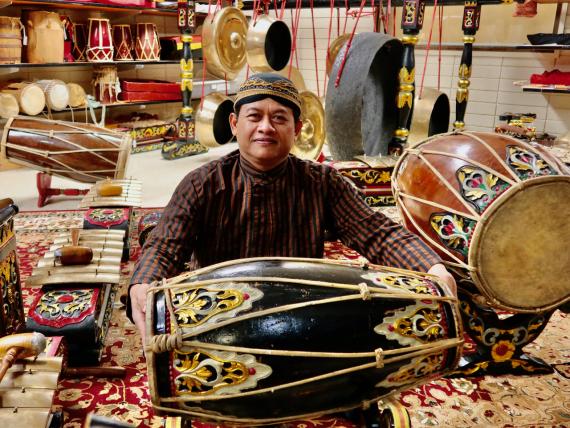The master Javanese gamelan musician Heri Purwanto from Indonesia performs with his students in this evening of music from central Java, Indonesia.
Event Background
The University of Washington School of Music is pleased to showcase music from the island of Java in the country of Indonesia. Java is rich with performance traditions in an array of regional styles. This evening features gamelan music associated with central and east Java.
Gamelan are ensembles largely composed of gongs and keyed percussion instruments. Although many such ensembles are found throughout Southeast Asia, gamelan are primarily associated with musical cultures on the Indonesian islands of Java, Madura, Bali, and Lombok. In Java, the most preferred material is bronze, but iron and brass are also used as less expensive alternatives.
Although different gamelan may vary slightly in their tunings, most gamelan music in central and east Java uses a five-tone tuning system called sléndro or a seven-tone tuning system called pélog. There are a number of modes, or pathet, in each tuning system. The tuning system (laras) and mode (pathet) are specified in the titles of compositions below. Tonight’s performance features compositions in pélog using about half of the instruments of the UW School of Music’s bronze gamelan, which is named Hapsari Kusumajaya (Heavenly Nymph Flower Power).
Most Javanese gamelan include four groups of instruments. The large gongs of various sizes mark the musical structure of repeated gong cycles. The largest hanging gongs (gong) mark the very end of each cycle while the smaller hanging gongs (kempul) and horizontal gongs (kenong, kethuk, and kempyang) divide the cycle into phrases. A family of one-octave metallophones (saron, demung, and slenthem) plays a skeletal version of the melody. A third group of instruments elaborates the melody and includes other metallophones (peking, gendèr, and gendèr panerus), the xylophone (gambang), gong-chimes (bonang and bonang panerus), flute (suling), bowed fiddle (rebab), and voice, although sometimes the saron, demung and slenthemelaborate the melody as well. Guiding the melodic elaboration is a conceptual melody that musicians know but that is not sounded by any one instrument. This melody, sometimes called the inner melody, is sounded when all of the instruments play together, and yet is not audible as a single line played on any one instrument. The drums (kendhang), the fourth group, control the tempo.
Biography
Heri Purwanto, a highly respected teacher, performer, and master musician of Javanese gamelan, comes from a family of musicians in Wonogiri, Central Java. After graduating from the college level academy (now Institut Seni Indonesia) in Surakarta, Central Java, at the top of his class in 2000, he taught gamelan at the University of California-Berkeley from 2001 to 2004 and directed the Berkeley-based ensemble Gamelan Sari Raras. Since returning to Java in 2004, Heri has continued his work as an artist, building and running an arts studio in his community as well as performing as a musician throughout Indonesia, as well as in Singapore, Thailand, China, and across the United States. He has been a Visiting Artist in the Ethnomusicology Program at the University of Washington in 2011, 2014, and 2019 and has performed with the Seattle-based ensemble Gamelan Pacifica. From 2014 to 2016 he taught gamelan at Earlham College in Richmond, Indiana, where he was in residence on a Fulbright award during the 2014-2015 year.
